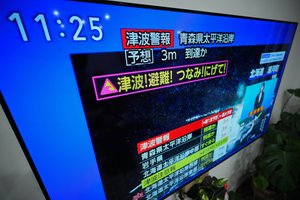By LISA VOGT/ Special to Asahi Weekly
May 24, 2022 at 14:30 JST
Echizen (current Fukui / Ishikawa Prefecture), Etchu (current Toyama Prefecture) and Echigo (current Niigata Prefecture)--these old area names all have something in common. The first part is the kanji meaning to “to crossover” or “to pass through”, and it derives from the geographical location of people “having to go beyond” this region to get to the emperor when the center of Japan was in Kyoto.
The furthest away was Echigo. With the Imperial Palace in Tokyo today, the names would be in reverse order by distance.
Nestled out in the countryside of Niigata Prefecture is Echigo-Tsumari. According to one view, the origin of the name lies in the phrase “dontzumari” (meaning “dead end” or “impasse”)--a name believed to have come about as the area is at the end of a basin, surrounded by mountains on all sides.
This year, the Echigo-Tsumari Art Triennale, renamed Echigo-Tsumari Art Field, will be held from April 29 through Nov. 13. Art is often housed in a box in a big city or comprises pieces in an outdoor exhibition space. The ETAT (or ETAF now) is an art festival that takes place throughout a vast 760-square-kilometer area, encompassing the municipalities of Tokamachi and Tsunan.
The Echigo-Tsumari region in Niigata Prefecture is known for its harsh snowy winters and depopulation. Despite the challenges people face, living and working with their land, called “satoyama,” there is an art of living well here that city folks miss.
ETAT makes for a perfect road trip. Pack your bags, get your sunglasses, stock up on some munchies and off you go! Hundreds of artworks dot the 200 or so villages. Take a look at the ETAT map, and you’ll see how inefficient and irrational it seems--you’ll be zigzagging and backtracking to visit places that arouse your curiosity.
While getting lost driving through beautiful rice paddies, you’ll see closed schools and previously abandoned structures reborn as installations, artsy scarecrows (whether designed that way or not) and real people doing real work on their land. Soon, the line between art and life gets blurred, and everything you come across becomes a work of art.
Driving through the countryside, through osmosis, I truly felt the meaning of “man is contained by nature.” By “crossing over” to a seemingly “dead end,” I could feel in the depths of my soul how I needed to be reminded of the need to feel a part of the natural world (plants, animals, landscape) and to marvel at and recommit to the human ingenuity of living in harmony, in an artful way with the elements.
* * *
This article by Lisa Vogt, a Washington-born and Tokyo-based photographer, originally appeared in the April 17 issue of Asahi Weekly. It is part of the series "Lisa’s Wanderings Around Japan," which depicts various places across the country through the perspective of the author, a professor at Meiji University.




















A peek through the music industry’s curtain at the producers who harnessed social media to help their idols go global.
A series based on diplomatic documents declassified by Japan’s Foreign Ministry
Here is a collection of first-hand accounts by “hibakusha” atomic bomb survivors.
Cooking experts, chefs and others involved in the field of food introduce their special recipes intertwined with their paths in life.
A series about Japanese-Americans and their memories of World War II